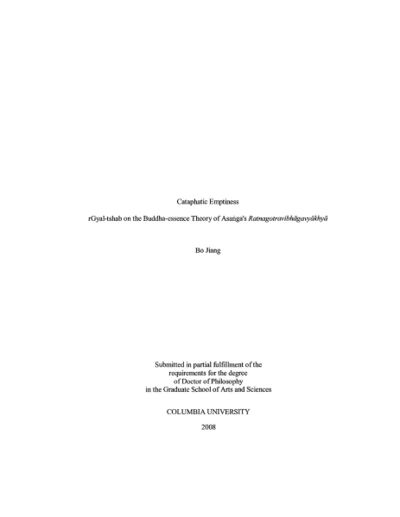Cataphatic Emptiness: rGyal-tshab on the Buddha-essence Theory of Asaṅga's Ratnagotravibhāgavyākhyā
< Books
| (8 intermediate revisions by the same user not shown) | |||
| Line 1: | Line 1: | ||
{{Book | {{Book | ||
|BookPerson={{Book-person | |BookPerson={{Book-person | ||
| + | |PersonPage=Jiang, Bo | ||
| + | |PersonName=Bo Jiang | ||
| + | }}{{Book-person | ||
|PersonPage=Rgyal tshab rje dar ma rin chen | |PersonPage=Rgyal tshab rje dar ma rin chen | ||
|PersonName=Gyaltsap Je Darma Rinchen | |PersonName=Gyaltsap Je Darma Rinchen | ||
| Line 6: | Line 9: | ||
|PersonPage=Asanga | |PersonPage=Asanga | ||
|PersonName=Asanga | |PersonName=Asanga | ||
| − | |||
| − | |||
| − | |||
}} | }} | ||
|FullTextRead=No | |FullTextRead=No | ||
| Line 43: | Line 43: | ||
***{{i|'Gos-lo's position on Buddha-essence|84}} | ***{{i|'Gos-lo's position on Buddha-essence|84}} | ||
***{{i|dGe-lugs-pa scholars' responses|89}} | ***{{i|dGe-lugs-pa scholars' responses|89}} | ||
| − | **{{i|3. A Comparison with Critiques of "Original-enlightenment" theory in Modern Chinese Buddhism|94}} | + | **{{i|3. A Comparison with Critiques of "Original-enlightenment" theory in<br>Modern Chinese Buddhism|94}} |
***{{i|A comparison of interpretations between 'Gos-lo and Zongmi|96}} | ***{{i|A comparison of interpretations between 'Gos-lo and Zongmi|96}} | ||
***{{i|Modern Chinese Critiques of "Original-enlightenment"|99}} | ***{{i|Modern Chinese Critiques of "Original-enlightenment"|99}} | ||
| Line 97: | Line 97: | ||
***{{i|The bees simile for latent state of hatred|216}} | ***{{i|The bees simile for latent state of hatred|216}} | ||
***{{i|The husks simile for latent state of misknowledge|216}} | ***{{i|The husks simile for latent state of misknowledge|216}} | ||
| − | ***{{i|The filth simile for intense outburst of attachment, hatred, and misknowledge|218}} | + | ***{{i|The filth simile for intense outburst of attachment, hatred, and<br>misknowledge|218}} |
***{{i|The floor simile for ground of instincts for misknowledge|219}} | ***{{i|The floor simile for ground of instincts for misknowledge|219}} | ||
***{{i|The fruit simile for addictions eliminated by the Path of Insight|220}} | ***{{i|The fruit simile for addictions eliminated by the Path of Insight|220}} | ||
| − | ***{{i|The tattered rags simile for addictions eliminated by the Path of Meditation|221}} | + | ***{{i|The tattered rags simile for addictions eliminated by the Path of<br>Meditation|221}} |
***{{i|The woman simile for addictions related to the Impure Stages|222}} | ***{{i|The woman simile for addictions related to the Impure Stages|222}} | ||
***{{i|The clay simile for addictions related to the Pure stages|223}} | ***{{i|The clay simile for addictions related to the Pure stages|223}} | ||
| Line 118: | Line 118: | ||
Part 2: Appendices | Part 2: Appendices | ||
| − | *{{i|1. A Special Edition of Chapter One of the ''Theg pa chen po rgyud bla ma'i ṭīkā'' (1a-72a and 64a-170b)|285}} | + | *{{i|1. A Special Edition of Chapter One of the ''Theg pa chen po rgyud bla ma'i ṭīkā''<br>(1a-72a and 64a-170b)|285}} |
**{{i|A. Topical Outline|285}} | **{{i|A. Topical Outline|285}} | ||
**{{i|B. Special Edition|306}} | **{{i|B. Special Edition|306}} | ||
*{{i|2. Translations|449}} | *{{i|2. Translations|449}} | ||
**{{i|A. The ''Mahāyānottaratantrarvyākhyā'' (Chapter One: 1.1-7.5 and 21.1-78.22)|449}} | **{{i|A. The ''Mahāyānottaratantrarvyākhyā'' (Chapter One: 1.1-7.5 and 21.1-78.22)|449}} | ||
| − | **{{i|B. The ''Theg pa chen po rgyud bla ma'i ṭīkā'' (Chapter One: 1a-72a and 64a-170b)|525}} | + | **{{i|B. The ''Theg pa chen po rgyud bla ma'i ṭīkā'' (Chapter One: 1a-72a and<br>64a-170b)|525}} |
| + | |StopPersonRedirects=No | ||
|AddRelatedTab=No | |AddRelatedTab=No | ||
}} | }} | ||
Latest revision as of 19:12, 6 June 2023
Abstract
This doctoral dissertation studies the Ratnagotravibhāga (Uttaratantra), the only surviving Indian Buddhist treatise on the Buddha-essence doctrine, by way of one of its major Tibetan commentaries, rGyal-tshab Dar-ma-rin-chen (1364-1432)'s Theg pa chen po rGyud bla ma'i ṭīkā. This project consists of three parts: a special edition of the first chapter of the Theg pa chen po rGyud bia ma'i ṭīkā, an English translation of the selected sections of that commentary, and a comparative analysis which follows six distinct lines of inquiry.
The six lines are: rGyal-tshab's doctrinal classification of the text; his critiques of absolutism, skepticism, and quietism in connection with diverse interpretations of the Buddha-essence doctrine in Tibetan traditions as well as a tentative comparison with critiques of the theory of "Original-enlightenment" in modern Chinese Buddhism; his analysis of the title of Tibetan version and the structure of the text; rGyal-tshab's
philosophical positions on reality, Element, and natural luminosity of the mind; his expositions of the tripartite Buddha-essence, its ten aspects, and the eighteen similes; and the notion "spiritual gene" understood by dGe-lugs-pas.
This comparative approach will provide a broader synthetic understanding of the role that Buddha-essence played as a doctrinal genre in Tibetan intellectual history.
| Citation | Jiang, Bo. "Cataphatic Emptiness: rGyal-tshab on the Buddha-Essence Theory of Asaṅga's Ratnagotravibhāgavyākhyā." PhD diss., Columbia University, 2008. |
|---|---|

